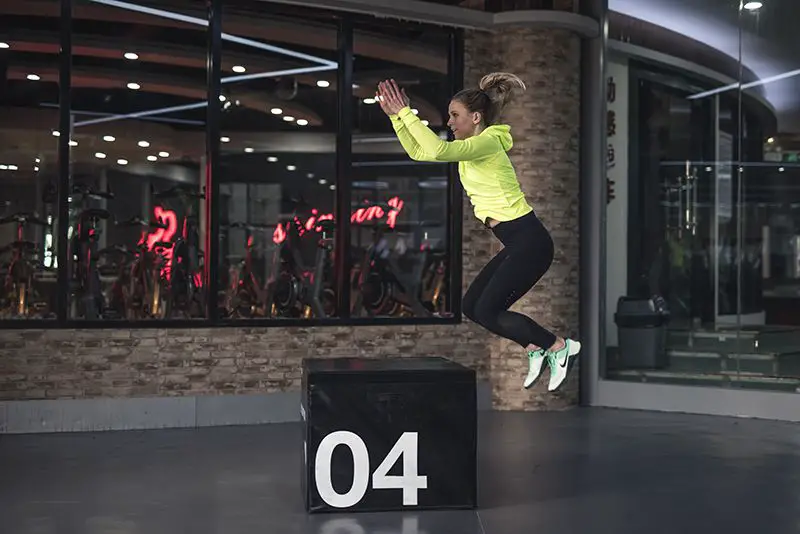Marathon Strength Training – 4 Sessions To Build Power And Endurance
Depending on the level of fitness, running a marathon can take anywhere between 2 and 6 hours. That’s a lot of steps and a lot of pounding for the body to take. So, it’s important to include specific marathon strength training to build the resilience in legs, core and even your mind to sustain those grueling 42.195 kilometers.
With a smile, of course. Because, you know, you paid for it.
Marathon strength training
Endurance athletes require two different types of fitness to be efficient. Those are aerobic fitness (heart & lungs) and ‘peripheral’ fitness (muscles and limbs).
Aerobic fitness is required to efficiently transport the oxygen to working muscles and be efficient and clearing the lactic acid from blood. This helps to run faster and fatigue slower.
However, including sessions that focus on building power will result in better running economy through a more efficient stride and also longer time to fatigue.
In fact, I’ve read a good quote recently:
For most of the people marathon is not an endurance event – it’s really a test of pure strength.
I personally subscribe to that 100%. My theory is that marathon runners should spend a fair amount of time building strong core, working on the lower body conditioning and adding more shorter intensity in their training schedules. It will help to prepare the body for all the pounding it will have to take.
Good news is that well-structured marathon strength training will be able to target both types of fitness. Right kind of training will improve overall muscle resilience and also stimulate endurance gains.

Combining strength training and running program
So how does it all work?
It’s all about the mitochondria – small powerhouses that are located in our muscles and generate energy. The more mitochondria there is in a muscle – the more energy is produced. With more energy available an athlete can maintain a faster effort longer (or the current effort may feel easier).
Mitochondria grow in response to ‘manageable’ stress – the kind when muscles are stimulated, but not overdosed. Combining strength training and running program is a very slippery slope, though. Too much high intensity causes fatigue to accumulate in muscles and actually forces the body to lose aerobic endurance.
Strength training for runners has to be explosive to maximize gains and very short to minimize fatigue.
So, strength training cannot be ‘classic’ as we know it – no ‘3 sets of 10’, no ‘training for size’, no muscle exhaustion and no 2 hours at the gym.
Marathon strength training sessions
Long runs are probably the best way to build strength for a marathon. As the athlete runs longer more muscle fibers are stimulated which promotes mitochondrial growth. That makes sense – after all, it’s what the body will have to do for 42.195 kilometers.
At some point, however, running longer will not be able to stimulate enough muscle fibers to promote additional mitochondria growth. Nor is it very healthy to run for 2.5+ hours due to all the pounding.
That’s when it’s time to take on specific marathon strength training sessions.
Running drills & strides
Drills are short warm-up like exercises that build strength in stabilizing muscles and promote good running form.
Strides, on the other hand, are slightly longer (up to 20 seconds) gradual accelerations to around 90 – 95% of maximum speed. These short bursts of speed promote good running form and improve overall running economy by boosting mitochondrial growth.
It’s best to include around 10 minutes of drills and strides (like the ones below) at the end of an easy run. Include a bit of rest in between to avoid accumulating fatigue.
‘Classic’ gym workout for runners
The idea of a gym session for runners is radically different from what a regular ‘gym-goer’ might imagine, as the focus of runners is not to build additional muscle (not throughout the season, at least).
The main goal of a strength session is to build resilience in legs, hips, glutes, hamstrings and core to maintain a good running form for as long as possible. That is possible with high repetitions, easy effort and short rest. Body weight exercises like squats, lunges and core exercises are great for it. One set is typically no longer than 40 seconds.
Related: 5 Core Exercises For Runners To Get Fast & Stay Injury-Free
Secondary goal is to use explosive strength to stimulate hormonal release and mitochondrial growth, which will benefit overall endurance and muscle economy. This is done with large weights (80%+ of max) on exercises that target prime movers (squats, deadlifts). 2-3 sets per exercise with rest interval typically around 5 minutes.
Hill repeats, trail running, hiking & stair climbing
Running uphill have long been used to improve overall strength in all lower-body. It engages hamstrings and glutes more than running straight, therefore promoting good running form.
For a good strength session do 4 hill repeats at marathon effort. Duration – up to a minute, rest interval – around 2 minutes. Build over time to up to 10. A good alternative is to go for an easy trail run in Zone 2.
Hiking and stair climbing provide a similar effect to running uphill. Since the intensity is much lower than in running (maybe not in stair climbing), you can do it for longer and have an aerobic benefit at well.

The Resilient Athlete
A Self-Coaching Guide to Next Level Performance in Sports & Life
Are you aiming to become a resilient athlete who is able to withstand any pressure? Be able to jump on any opportunity? Take any challenge life throws at you head on?
Then this book is for you.
Learn morePlyometrics
Plyometrics are short explosive or jump exercises. Intensity of these exercises forces muscles to repeatedly lengthen and contract at maximum speed.
An average session will take you around 10-15 minutes and it’s best to combine it with an easy run or do after a long easy run. Have an easy day after the session, as complete recovery may take anywhere from 24 to 48 hours.
Duration and number of sets. Pick 3-4 exercises and do 3-4 sets of each. Spend no more than 20 seconds on every exercise and don’t overdo it. The whole point of the exercise is to be very short.
Intensity. The reason exercises are very short is that it’s an all-out effort. Execute each jump with your heart.
Rest Interval. Around 1-2 minutes. Check with your heart rate – it should drop to Zones 1 or 2 before you start your next exercise. Better take an extra minute of rest than an extra jump.
Did you find this information useful? Share the post with others using the buttons below.
My first marathon training update
Update: I ran my first marathon and it was a roller coaster of emotions. Read my race report here, if you’re interested.
This was the hardest week of my training so far. As I have a 6K race coming up, I am making this my peaking week and working actively on speed.
As usual, I’ve mixed up my training with swimming and cycling to reduce stress on legs and give the body some aerobic work. I also added one strength session in the middle of the week where I did a bit of body weight exercises for every muscle group.
Related: How To Overcome Running Fatigue While Training For A Marathon
I could have spent more time stretching this week – probably something to improve over the next week. But generally, I feel pretty good going into a short taper for complete recovery. I feel I deserved it.
My marathon strength training sessions
This week I had 4 runs in total:
- Speed workout – 4 x 1K intervals in Zone 4 with long rest
- Long run with two 10 minute sections at marathon effort
- Build up run to a tempo pace
- Easy run with 10 x 10sec bursts at 90% effort
Overall, I felt really good towards the end of the week during a build up run and a long run. Also, the interval work this week went better than usual, as I was able to stay in Zone 4 throughout most of the efforts. So, it didn’t feel too taxing on the whole body.

Tags In
Andrejs
Related Posts
Leave a Reply Cancel reply
GET A FREE TRAINING PLAN
Subscribe to my email list and get access to a free 4-week “back in shape” training plan
You’ll also get two full-body strength sessions and some other goodies!

How did I get here?
Hey there! My name is Andrejs and I am here to inspire, entertain and get you fit for any adventure.
I went from being an over trained pro athlete to an endurance coach sharing how to listen to your body and live life to the fullest.
Traveling, new sports & activities brought new meaning to my training and made it much more effective, fun and enjoyable. And I'm here to help you do the same.


